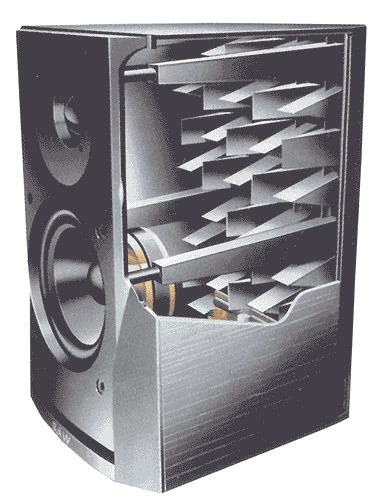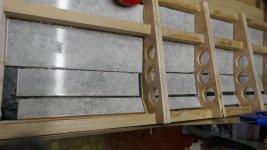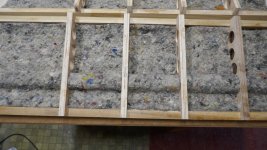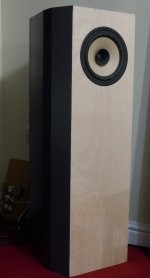I guess the real question is, if it is so engaging, why are you entertaining changing it ?
That driver should be the cat's meow.
And you've dialed in the passive ckt.
How much time/money do you want to spend ?
If the specs are accurate, I get a 2.43ft3 sealed for a qtc .707 making F3=fsb=55hz.
So, to me, it is a moot point of 2.4 vs 2ft3.
I think I read from a designer that a driver "sounds" better when it is warmed up, maybe after 15 minutes of playing, but I may be wrong.
Me, I like big sealeds and I can not lie (lol). To me there is less back pressure allowing the driver to not "fight" going in the box, then springing out. Then again, that spring force helps limit excursion = less garble maybe.
I would try a 5ft3 sealed box (qtc .577) in 1 : 1.618 ratios, and stuff the schmoo out of the box (not cheap either).
91mm tall x 55cm wide x 35mm deep, bracing up to you.
Ideally the driver would be 55cm from the bottom, but you can try a box with the driver at the top.
This is a hobby, right ?
You may come to the conclusion that their box is best, it certainly has plenty of bracing.
So your time, your ears, you opinion, and even get back to us here with your conclusions !!!!!
That driver should be the cat's meow.
And you've dialed in the passive ckt.
How much time/money do you want to spend ?
If the specs are accurate, I get a 2.43ft3 sealed for a qtc .707 making F3=fsb=55hz.
So, to me, it is a moot point of 2.4 vs 2ft3.
I think I read from a designer that a driver "sounds" better when it is warmed up, maybe after 15 minutes of playing, but I may be wrong.
Me, I like big sealeds and I can not lie (lol). To me there is less back pressure allowing the driver to not "fight" going in the box, then springing out. Then again, that spring force helps limit excursion = less garble maybe.
I would try a 5ft3 sealed box (qtc .577) in 1 : 1.618 ratios, and stuff the schmoo out of the box (not cheap either).
91mm tall x 55cm wide x 35mm deep, bracing up to you.
Ideally the driver would be 55cm from the bottom, but you can try a box with the driver at the top.
This is a hobby, right ?
You may come to the conclusion that their box is best, it certainly has plenty of bracing.
So your time, your ears, you opinion, and even get back to us here with your conclusions !!!!!
Last edited:
norman bates, thank you for your thoughts, it is good to have some alternative views.
Here is a reality check. On Monday we went to hear Royal Liverpool Philharmonic play in Birmingham Symphony hall. (Strauss Alpine Symphony). Our seats were middle of stalls similar to the position for speaker listening. The concert was great. Next morning I listened to a quality stream of same work at a realistic level. Usually home hi-fi sounds pale in comparison. This system sounded terrific and I listened right through with great enjoyment. The essence of the live concert and power of the big orchestra came across. Any lingering doubts I had were blown away.
An attempt to improve on this is obviously fairly costly exercise but it is like trying to get closer to a perfection. I have simulated a 2m mass loaded QWT and the 61L a box plus a 122L sealed box. For my own information I traced them so all sims are on the same graph. It’s a bit messy but is attached.

The 61L and 122L are the smoother curves, the bigger box rolls off slightly sooner by a fraction of dB but maintains output lower. The MLQWT has a less even FR, maintains bass for a fraction longer and drops away a little faster.
Now here is another consideration; SEAS say “We urge caution against exceeding the maximum excursion limits of the driver in enclosure designs that do not provide a high degree of rear loading at bass frequencies.”
The cone displacement increases quite a bit in the designs that have open ends and most amplifiers can deliver bass at least to 10Hz. The sealed boxes do not suffer from this. Below is cone displacement for 2m MLQWT increasing rapidly on low notes for a low power input.

Here is a reality check. On Monday we went to hear Royal Liverpool Philharmonic play in Birmingham Symphony hall. (Strauss Alpine Symphony). Our seats were middle of stalls similar to the position for speaker listening. The concert was great. Next morning I listened to a quality stream of same work at a realistic level. Usually home hi-fi sounds pale in comparison. This system sounded terrific and I listened right through with great enjoyment. The essence of the live concert and power of the big orchestra came across. Any lingering doubts I had were blown away.
An attempt to improve on this is obviously fairly costly exercise but it is like trying to get closer to a perfection. I have simulated a 2m mass loaded QWT and the 61L a box plus a 122L sealed box. For my own information I traced them so all sims are on the same graph. It’s a bit messy but is attached.
The 61L and 122L are the smoother curves, the bigger box rolls off slightly sooner by a fraction of dB but maintains output lower. The MLQWT has a less even FR, maintains bass for a fraction longer and drops away a little faster.
Now here is another consideration; SEAS say “We urge caution against exceeding the maximum excursion limits of the driver in enclosure designs that do not provide a high degree of rear loading at bass frequencies.”
The cone displacement increases quite a bit in the designs that have open ends and most amplifiers can deliver bass at least to 10Hz. The sealed boxes do not suffer from this. Below is cone displacement for 2m MLQWT increasing rapidly on low notes for a low power input.
The nicest of those curves is the 122 litre sealed IMO.
dave
dave
Last edited:
Yes I agree. I somehow thought that more could be obtained with the MLQWT but I am not so sure now. I have a number of ideas - just what ifs - such as slicing off the back of the existing cabinet and adding an extension to double the volume. Might need planning permission for that though.
the extra 30hz will be inaudible due to a full range driver that would distort everything above it, by the time you get audible (?) output sitting 8-10' away from a pair of 8" not floor, wall, or corner loaded. And the harmonic distortion will be nasty also.
My theory is better front to back pressure on a full range driver allows it to "track" the signal easier.
just a theory...........
Anything below Fs/qts is basically gain due to a spring force, to a limit, or a resonant box.
I admire all of the ways to help us get some more bass, be it ported, mltl, pencil, whatever.
I especially appreciate the way a box can limit excursion, say as a pencil.
Because limiting excursion = allows for less gargle.
And again, I cringe when people focus on excursion graphs for full range drivers.
Your mids will be extremely distorted (or gargled) trying to push 30 watts of bass and mid/treble through a single cone at the same time.
Mdf is cheaper to work with for a proof of concept, but not necessarily if you are paying someone else to make the box (retail).
If you are seeking orchestra output, you will need to actively cross to a subwoofer, or even up to 200hz for woofers, and that leads to its own set of pluses and minuses.
My theory is better front to back pressure on a full range driver allows it to "track" the signal easier.
just a theory...........
Anything below Fs/qts is basically gain due to a spring force, to a limit, or a resonant box.
I admire all of the ways to help us get some more bass, be it ported, mltl, pencil, whatever.
I especially appreciate the way a box can limit excursion, say as a pencil.
Because limiting excursion = allows for less gargle.
And again, I cringe when people focus on excursion graphs for full range drivers.
Your mids will be extremely distorted (or gargled) trying to push 30 watts of bass and mid/treble through a single cone at the same time.
Mdf is cheaper to work with for a proof of concept, but not necessarily if you are paying someone else to make the box (retail).
If you are seeking orchestra output, you will need to actively cross to a subwoofer, or even up to 200hz for woofers, and that leads to its own set of pluses and minuses.
Thank you again Norman for your input. Just for the record I rarely listen to big orchestral works at home as they are best heard in appropriate locations.
Looking at the simulated response graphs it seems that they show the physical limits of an 8” FR driver. One approach might be preferred by some listeners but the differences are not massive. All things considered the 60L design recommended by SEAS may be pretty much optimal. (There’s a surprise).
The use of hornresp has been fun and informative –thank you to David McBean.
I don’t think it is worth building another enclosure to test this thought experiment as I am happy with the performance of the existing loudspeaker. For me it remains an open question as to whether or how more can be squeezed out of this driver.
Looking at the simulated response graphs it seems that they show the physical limits of an 8” FR driver. One approach might be preferred by some listeners but the differences are not massive. All things considered the 60L design recommended by SEAS may be pretty much optimal. (There’s a surprise).
The use of hornresp has been fun and informative –thank you to David McBean.
I don’t think it is worth building another enclosure to test this thought experiment as I am happy with the performance of the existing loudspeaker. For me it remains an open question as to whether or how more can be squeezed out of this driver.
Not sure if you've sim'ed a classic down-tapered TL/ML-TL? Much shorter line and lesser total volume for the same quarterwave frequency alignment. In my experience these big-magnet low-Qts fullrange drivers thrive in them.
My test music for bass: organ, piano, and Dvorak's bass drum concerto nee New World Symphony. Various TL/TLonken: 2" 3.75L1.05m, 4.5" 6L1.2m, 5.5" 7L1m, 5.5" 10L1.3m, 8" 17L1.5m including Fostex F200A (for which 25L1.7m is planned). My current space/mass/cost constraints favor simple compact designs, but I'm sure they can be super-sized in CSA to deliver even more.
My test music for bass: organ, piano, and Dvorak's bass drum concerto nee New World Symphony. Various TL/TLonken: 2" 3.75L1.05m, 4.5" 6L1.2m, 5.5" 7L1m, 5.5" 10L1.3m, 8" 17L1.5m including Fostex F200A (for which 25L1.7m is planned). My current space/mass/cost constraints favor simple compact designs, but I'm sure they can be super-sized in CSA to deliver even more.
Good suggestion wchang. I have looked briefly at TL but will do some more on them. I have the feeling, in agreement with Norman that this is about the most that can be reasonably got from the particular driver. The bass is actually strong and tuneful when it exists on the recording.
It occurs to me that using the F8 only above say 400Hz and combing with a matched LF driver would be interesting but I have not really looked into that possibility yet.
It occurs to me that using the F8 only above say 400Hz and combing with a matched LF driver would be interesting but I have not really looked into that possibility yet.
Most go for a smaller full range driver if you are crossing at 400hz.
A smaller driver isn"t "breaking up" as much in the higher frequencies, or they can be more pistonic (spelling ?).
Going from a full range driver, you may only enjoy a 6db time/phase crossover with matching offset for acoustical centers.
You would have to decide for yourself what you think sounds better.
A smaller driver isn"t "breaking up" as much in the higher frequencies, or they can be more pistonic (spelling ?).
Going from a full range driver, you may only enjoy a 6db time/phase crossover with matching offset for acoustical centers.
You would have to decide for yourself what you think sounds better.
Another thought experiment is about the internal reflections of a rectangular box. Trying to get the best possible sound from the driver how significant are the internal waves?
A closed box of similar volume with a sectional shape such as this would alter the internal reflections.

I think a mass of standing waves between 1KHz and 3KHz would be inhibited. Could this make the speaker better?
A closed box of similar volume with a sectional shape such as this would alter the internal reflections.

I think a mass of standing waves between 1KHz and 3KHz would be inhibited. Could this make the speaker better?
Last edited by a moderator:
The deviations in your sketches dimensions are not that large, they will not mob=ve resonances much, To achieve that something of this magnitude.

dave

dave
Ah! I sort of remember that speaker. So the question is, would a really solid well damped box, possibly treated with these pointy bits improve the sound. If the coloration from the box and the waves reflected back through the cone were reduced a lot, in theory it should sound better.
To continue the story… I liked the SEAS very much and considered making an enclosure to hear them nearer to their best. This project was an experiment which I hoped would yield interesting results on the sound and would show the effect a different enclosure would make. It has taken about a month to build after weeks of consideration, researching and design bearing in mind the helpful comments received. I decided to stay with a sealed cabinet of 60-65L. The design has:-
The development has worked and I am very happy with the result. Each speaker weighs about 10Kg more than the original birch ply SEAS design.
The immediate impression was of a quieter speaker with a smooth and detailed sound quality. The cabinet does seem to be emitting less noise, and the reproduction is more clear and detailed. Bass is solid and treble very clear. The speaker is sweeter and I think apart from less noise being emitted through the cabinet sides, less is being reflected from the back and affecting the cone. Piano music is strikingly good.
The change makes quite a difference and I found it possible to reduce the intermediate treble cut by several dB. For much music it is possible to switch it to zero.
I have now been listening to these for two months. The freedom from unease with the sound is noticeable, the speaker seems to have less character of its own and music speaks clearly. The previous version, while hugely entertaining and arresting does seem a bit more tiring and it imposes its character on things more. I find I want to listen more often and to more kinds of music.




- A lozenge shaped cross section made with flat panels of 18mm birch and hardwood ply with bracing so that the sides were divided up into many more small panels of differing sizes.
- The sides employ several layers of materials to reduce resonances, including rubber, ceramics and 15mm wool felt bonded with spray contact adhesive.
- Front and back panels are double thickness 18mm ply.
- Back panel is lined with anechoic foam wedges.
The development has worked and I am very happy with the result. Each speaker weighs about 10Kg more than the original birch ply SEAS design.
The immediate impression was of a quieter speaker with a smooth and detailed sound quality. The cabinet does seem to be emitting less noise, and the reproduction is more clear and detailed. Bass is solid and treble very clear. The speaker is sweeter and I think apart from less noise being emitted through the cabinet sides, less is being reflected from the back and affecting the cone. Piano music is strikingly good.
The change makes quite a difference and I found it possible to reduce the intermediate treble cut by several dB. For much music it is possible to switch it to zero.
I have now been listening to these for two months. The freedom from unease with the sound is noticeable, the speaker seems to have less character of its own and music speaks clearly. The previous version, while hugely entertaining and arresting does seem a bit more tiring and it imposes its character on things more. I find I want to listen more often and to more kinds of music.




- Home
- Loudspeakers
- Full Range
- SEAS EXOTIC F8 speaker build